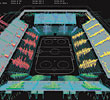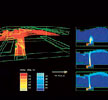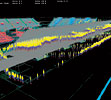A New Era for Fire Protection and Life Safety
The design team did not rely solely on superior fireproofing for structural protection. The elevator and stair cores are high-strength, reinforced, poured-in-place-concrete enclosures, varying in thickness from 12 to 28 inches depending on floor level. The issues regarding the cores lead directly to the third ring of defense-evacuation, which takes place, of course, inside the cores. The first improvement was simple enough-increase the space by making the stairwells 20 percent wider than the code requires. The goal was to increase the flow of occupants out of the building without impeding the counterflow of emergency responders rushing in.
While it's a given that stairwells, regardless of width, must remain clear of smoke, there are different schools of thought on the best way to achieve this. Galioto says that New York City codes show a preference for purging smoke that migrates into the stairwells via a ventilation system. SOM went a step further and adopted the International Building Code, which, unlike New York City's current regulations, requires both ventilation and pressurization. At 7WTC, in addition to an exhaust system, air will be forced into the stairwells, creating a positive pressure within the enclosure, thus preventing most smoke from invading the space around door frames. In addition, the fire department will control the system by regulating both pressurization and exhaust, depending on actual conditions.
The team made every effort to guarantee uninterrupted lighting in the stairwells. Local codes require that stairwells in commercial buildings be finished with photo-luminescent paint that will glow in the dark in the event of total power failure. The engineers added a redundancy between the generators and the paint and backed up the generators with a battery-powered source.
The stairs reach a transfer level toward the base on the building. At this juncture, the two stairwells split into four at the building's perimeters, in order for occupants to exit directly to grade, rather than into the public lobby. At the transfer level, interactive signs direct occupants to specific paths of egress. And as with all the life-safety features, the signs can be manually overridden by the fire department, as the situation dictates.












